A structural growth company on a single-digit P/E
NZME (New Zealand Media and Entertainment) is New Zealand’s most established media business, reaching a
total audience of over 3.4 million New Zealanders. NZME demerged from APN News & Media in 2016 and has a
market capitalisation of approximately NZ$240m. Its portfolio includes the nation’s largest newspaper by circulation,
The New Zealand Herald, New Zealand’s most popular commercial radio station Newstalk ZB, and the country’s
leading digital audio/podcast platform with iHeart Radio. Incredibly, NZME reaches over 85% of Kiwis. For 2021,
NZME management expects 49% of group revenue will have come from print and audio advertising, 24% from
reader payments and subscriptions, 24% from digital classifieds or digital advertising and 3% from other sources.
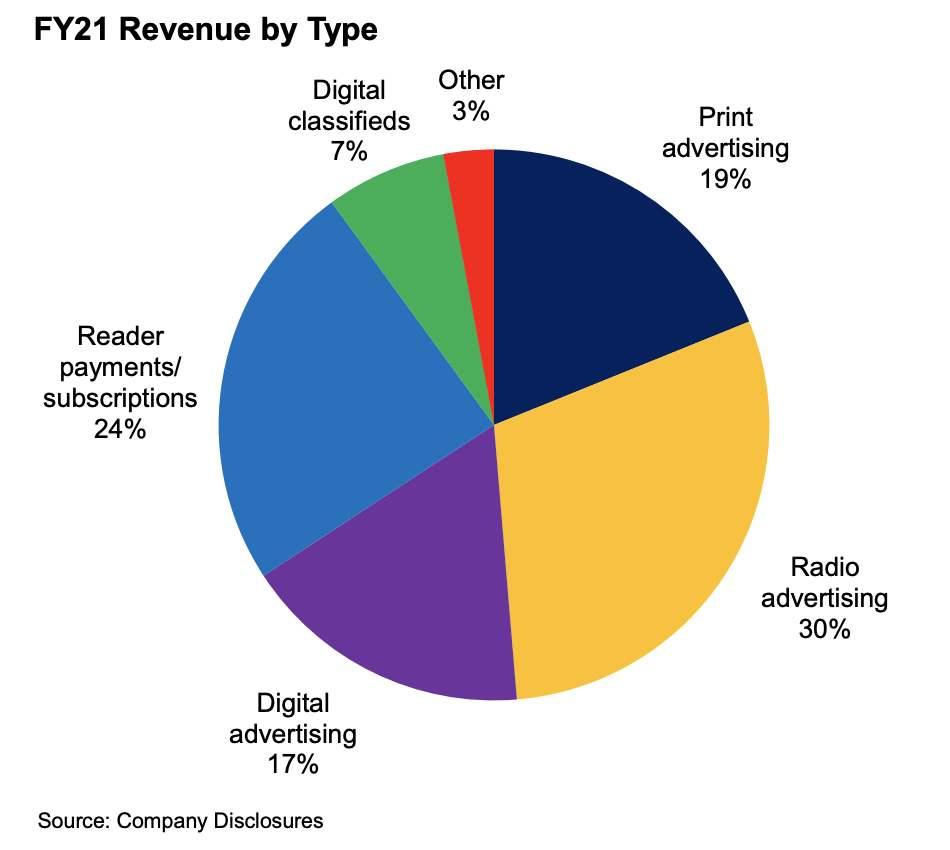
Despite a growing market position and increasing consumer demand, traditional media businesses have long been considered poor investments due to the disruption that has challenged business models across the sector. In relation to news media specifically, print circulation has declined and the corresponding advertising spend has largely moved online where digital platforms, most notably Google and Facebook, have taken a large portion of the previous revenue base.
In this context, what would make NZME an attractive investment? In this newsletter we discuss Auscap’s investment
thesis for NZME, including the multi-year transformation that the business has undergone and the opportunity as
NZME emerges as a modern, digital, subscription-led business with growing profitability, free cash flow and
significant reinvestment opportunities.
Business overview
NZME has a very well established market position within New Zealand. NZME represents 47.8% of New Zealand
print advertising revenue, 41% of radio revenue and 25.2% of digital display advertising revenue. These market
shares have consistently grown in recent years. The New Zealand Herald, founded in 1863, is analogous to the
Sydney Morning Herald or The Age in an Australian context. It is the fifth most popular website by views in New
Zealand. It has only one scale competitor, Stuff, a rational player comparable to Newscorp’s Australian tabloids,
which Stuff management recently acquired from Nine Entertainment. NZME’s journalism also serves an important
public service and we support NZME’s continued investment in local journalism, with NZME dedicating almost 300
editorial staff across more than 20 locations to “keeping Kiwis in the know”.
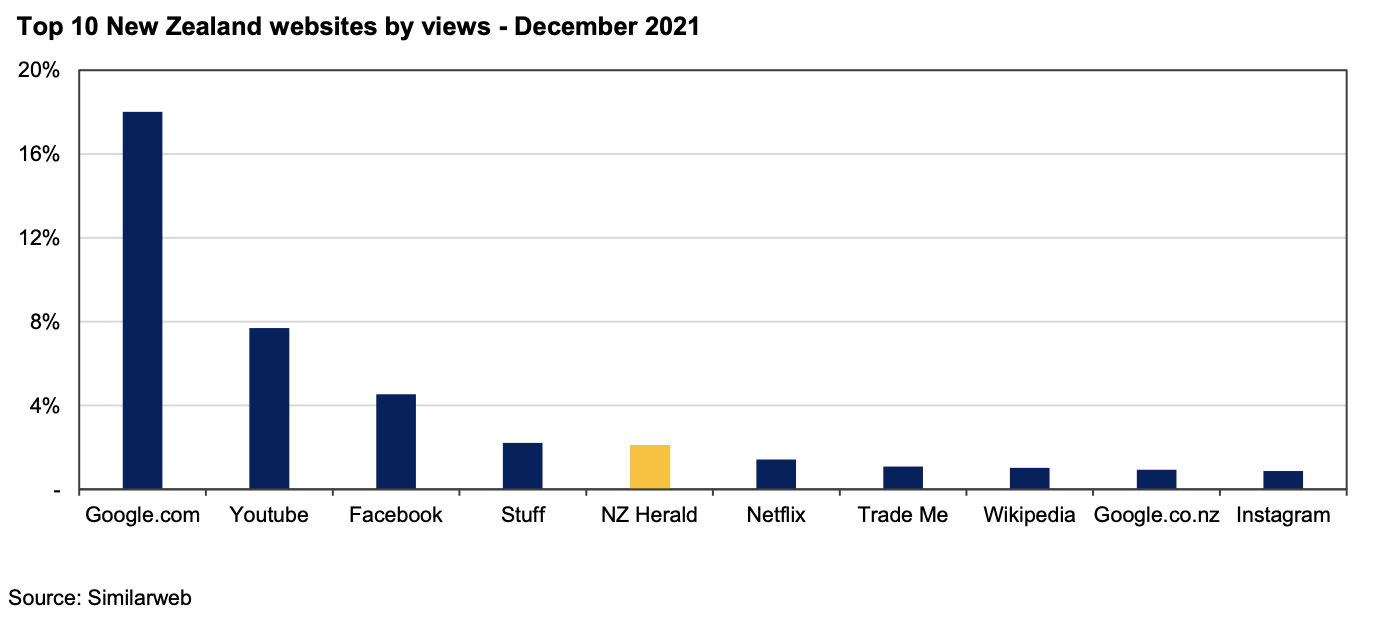
Traditional media structural dynamics
Print circulation across the globe has dropped materially over the last 15 years, with The New Zealand Herald’s
circulation more than halving from its 2006 peak. This has placed significant ongoing pressure on NZME’s print
advertising, subscription and newspaper sales revenue.
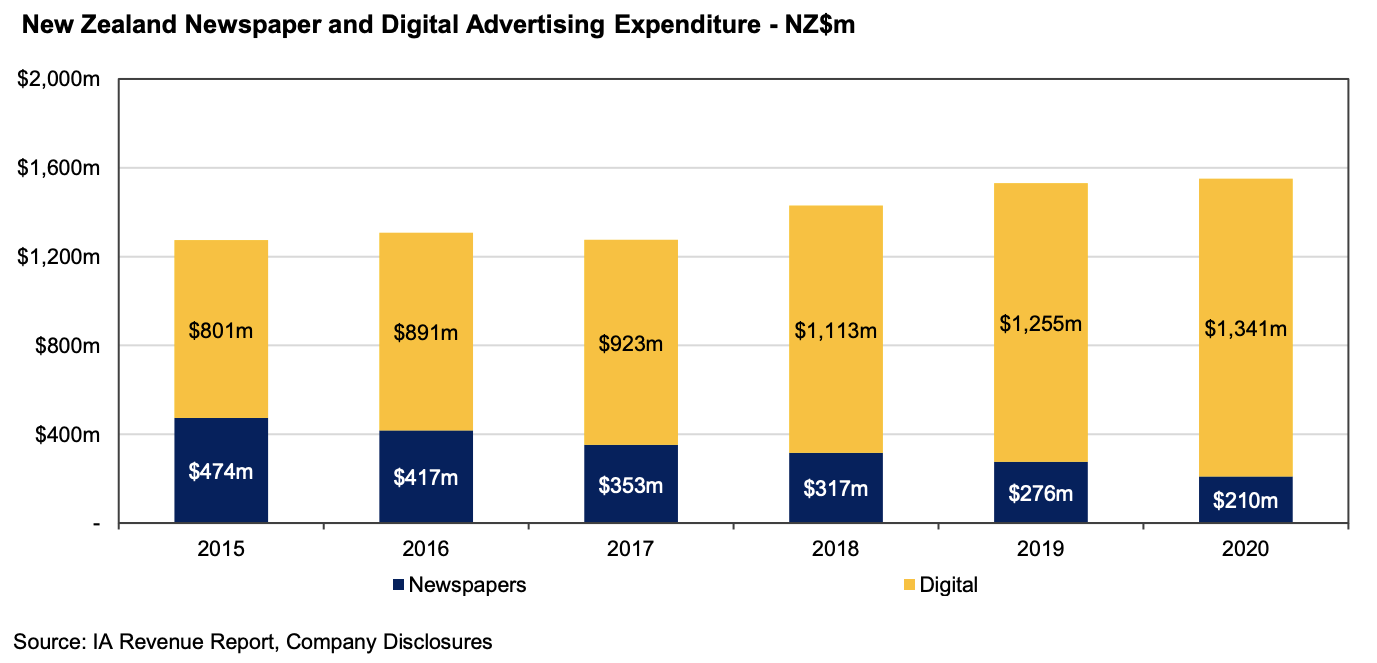
NZME has responded to these challenges with firm cost control and investments into its digital presence. There are now some signs suggesting NZME could be emerging from these industry challenges.
Management has guided for 48% of NZME’s 2H21 publishing advertising revenue to be digitally derived, suggesting NZME’s publishing advertising revenue is on the cusp of becoming predominantly from digital sources.
Digital display advertising is still exposed to the swings of the advertising market, as is the case with a large part of Google or Facebook’s advertising revenue, but its long-term trajectory has been strongly positive. Should publishing advertising revenue become predominantly digital, then we would anticipate overall publishing advertising revenue to move back into growth.
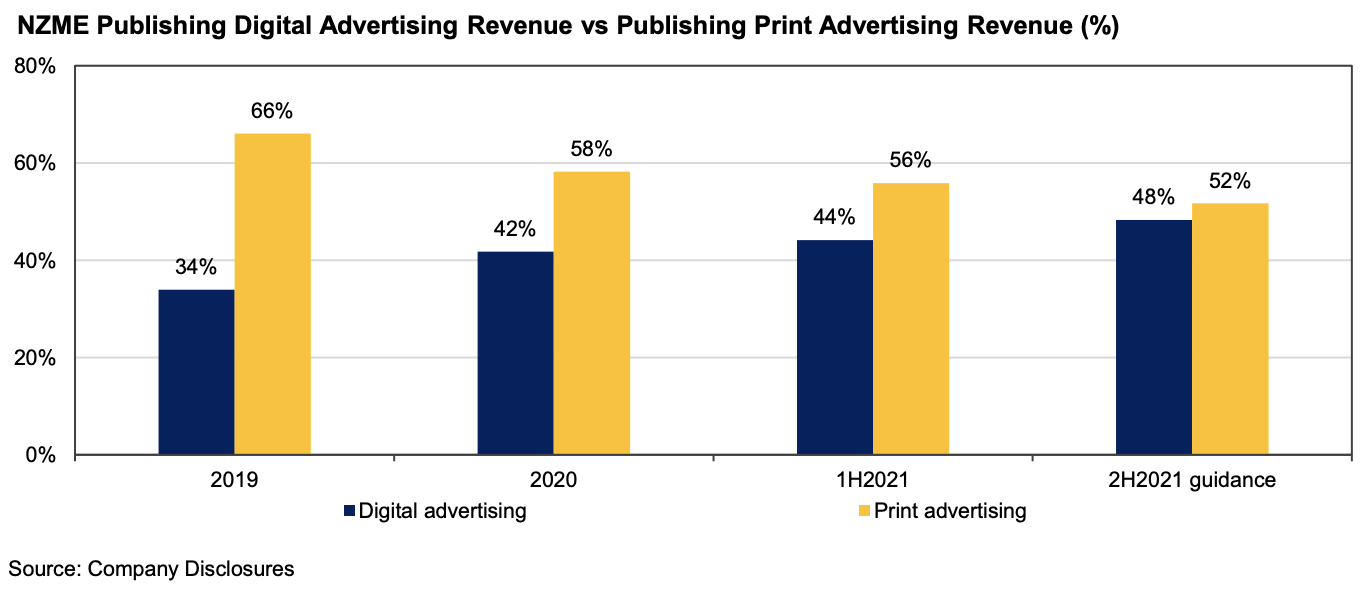
Similarly, NZME is making significant progress in converting its print subscriber base to digital subscribers. In April 2019, The New Zealand Herald launched a digital paid premium subscription option, combining its best proprietary content with third-party content from partners such as The New York Times, The Financial Times and Washington Post. This product has been highly successful, with The New Zealand Herald now having almost as many digital only subscribers as print only subscribers. The growth of the digital subscription offering has allowed NZME to stabilise its publishing subscription revenue in recent years, whilst also providing NZME with the data to improve its digital advertising monetisation. In the coming years, management expects digital-only subscriptions to more than triple and we anticipate price increases will follow improving yield. If this outcome eventuates, it would likely result in subscription revenue being another source of publishing revenue growth in the coming years.
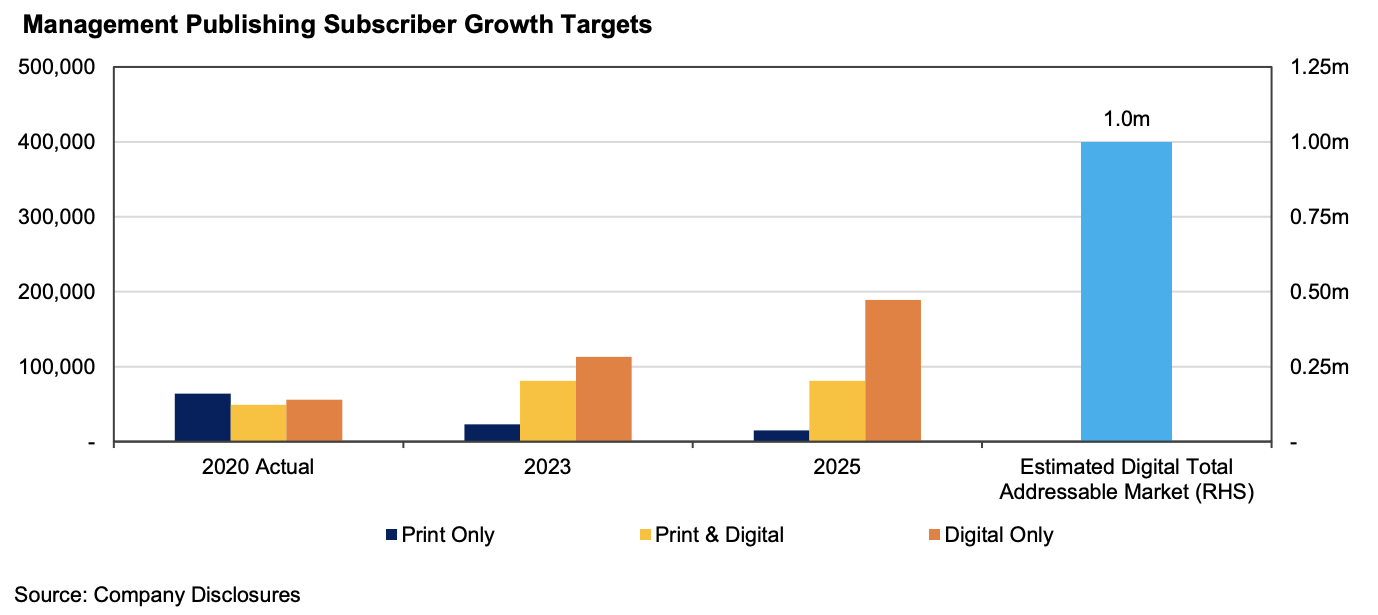
In contrast to print, radio in New Zealand has proven relatively resilient, maintaining its position as a particularly popular medium for consuming news and other audio content during morning and afternoon commutes. Radio audiences in New Zealand have grown steadily, recently reaching a weekly audience of 3.7 million, representing over 70% of the New Zealand population.
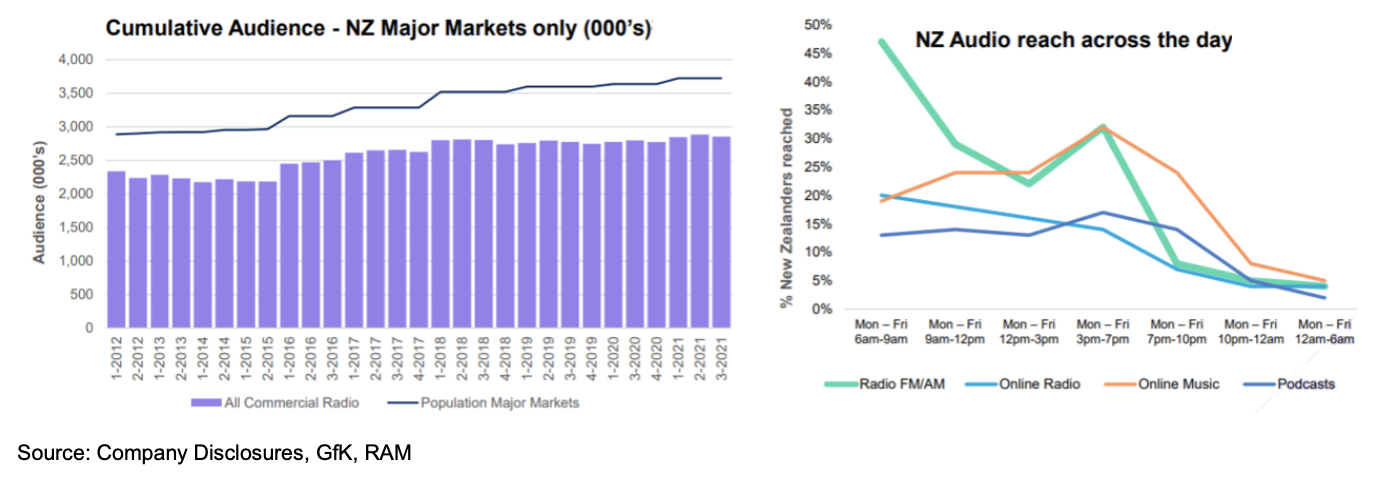
This resilience has led to NZME’s radio advertising revenue holding constant over time, excluding the recent
COVID-induced drop.
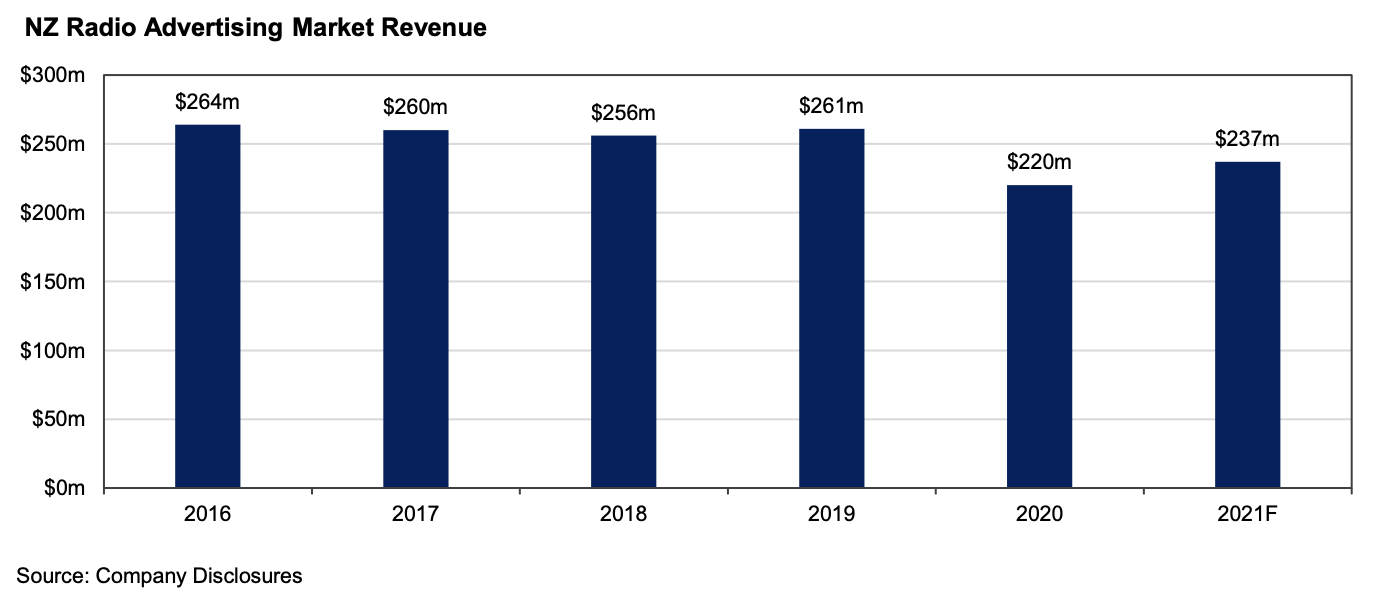
There is some risk that the continued integration of apps like Apple CarPlay or Android Auto into new vehicles will
cause audio streaming platforms such as Spotify to threaten NZME’s dominance of the commute over time.
However NZME’s local news content is difficult for global peers to replicate. NZME’s leading iHeartRadio offering
is a beneficiary of the growth in digital radio consumption and New Zealand’s automotive parallel import model has
led to the country structurally having one of the oldest car fleets in the developed world, with an average age of
14.5 years (1). NZME is targeting continued growth in radio audience share, revenue share and digital audio revenue,
along with margin expansion.
In our view, the combined result of the above dynamics is that after a long period of facing structural headwinds,
NZME’s core media businesses appear to be on the cusp of transitioning to a higher margin, digitally led business
with recurring revenues and potential exposure to structural growth tailwinds. If NZME can continue to execute on
this ambition, we believe there are significant valuation implications.
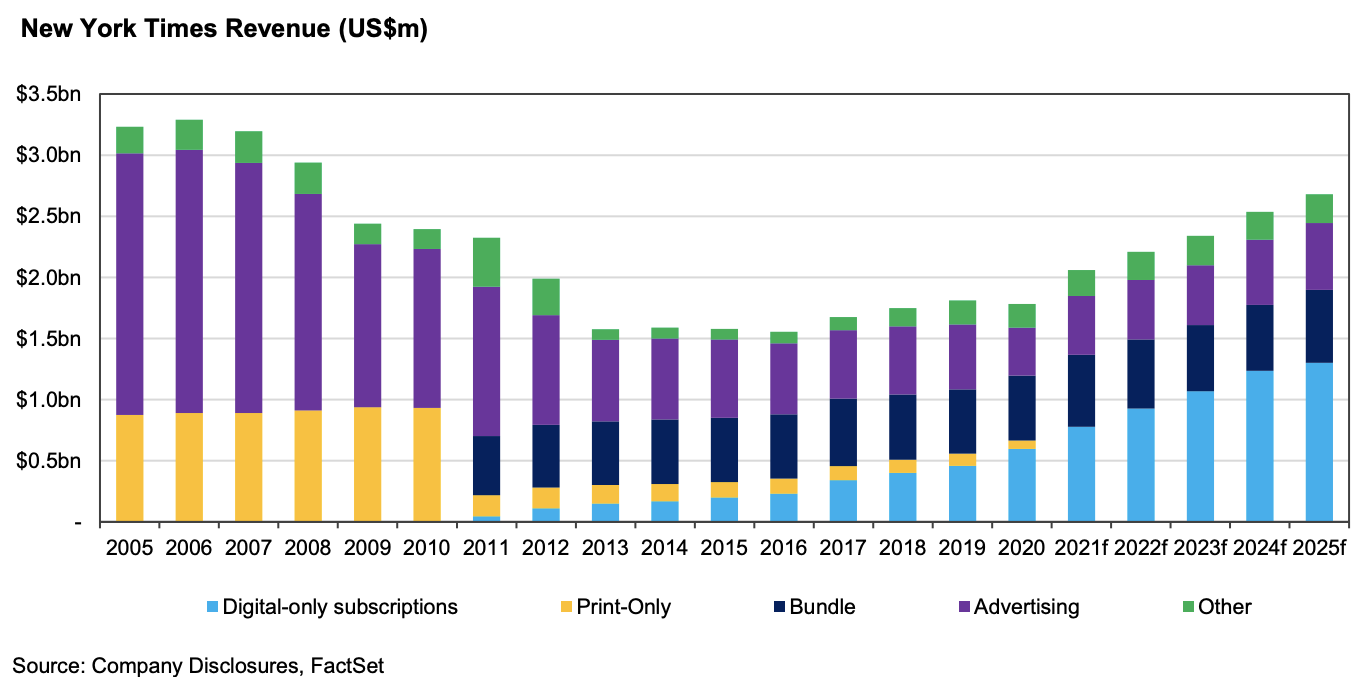
Whilst not a perfect comparison, The New York Times (NYT) serves as an interesting case study. In 2011 the analyst community was bearish, with one analyst writing “weak print trends and expense pressures will lead to downward estimate revisions and pressure on the stock… Sell.” But growth in digital subscriptions and digital advertising eventually returned the business to growth. In addition, the NYT’s digital subscribers proved incremental, with the NYT recently reaching over 8 million subscribers relative to circa 1 million subscribers before it launched digital subscriptions.
The analyst community now praise the business’ digital growth outlook, high
incremental digital margins, recurring subscription revenue and favourable content costs relative to Spotify and
Netflix. Over this period, the P/E multiple of the NYT has expanded considerably from 10x to 33x, partly reflecting
a change in perception around the longevity, profitability and growth outlook of the business. Whilst The New
Zealand Herald does not have the global brand strength of the NYT, we think it shares many of its attractive
characteristics: strong market position with leading brand recognition, high incremental margins, largely fixed
content costs and a positive digital growth outlook.
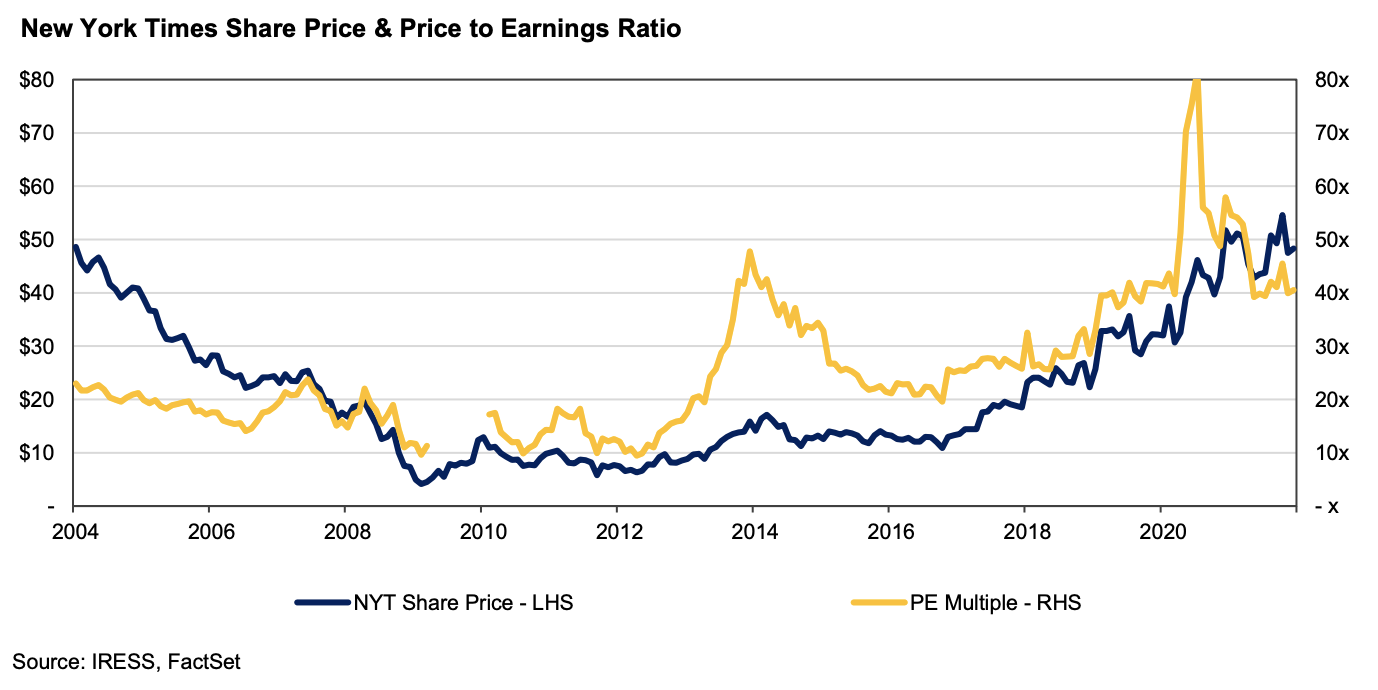
COVID-19 Impact
We have seen three significant impacts from COVID-19 on NZME. The first impact was a large hit to the New Zealand advertising market. The three largest advertising categories in New Zealand are Real Estate, Travel and Automotive. Travel advertising has more than halved over the last 18 months, due to the impacts of closed borders and lockdowns. Real estate and automotive advertising have also been somewhat depressed as the recent property and auto booms reduced the need to advertise. NZME’s recent earnings growth has been achieved despite these cyclical advertising revenue headwinds, with further upside likely if these trends reverse.
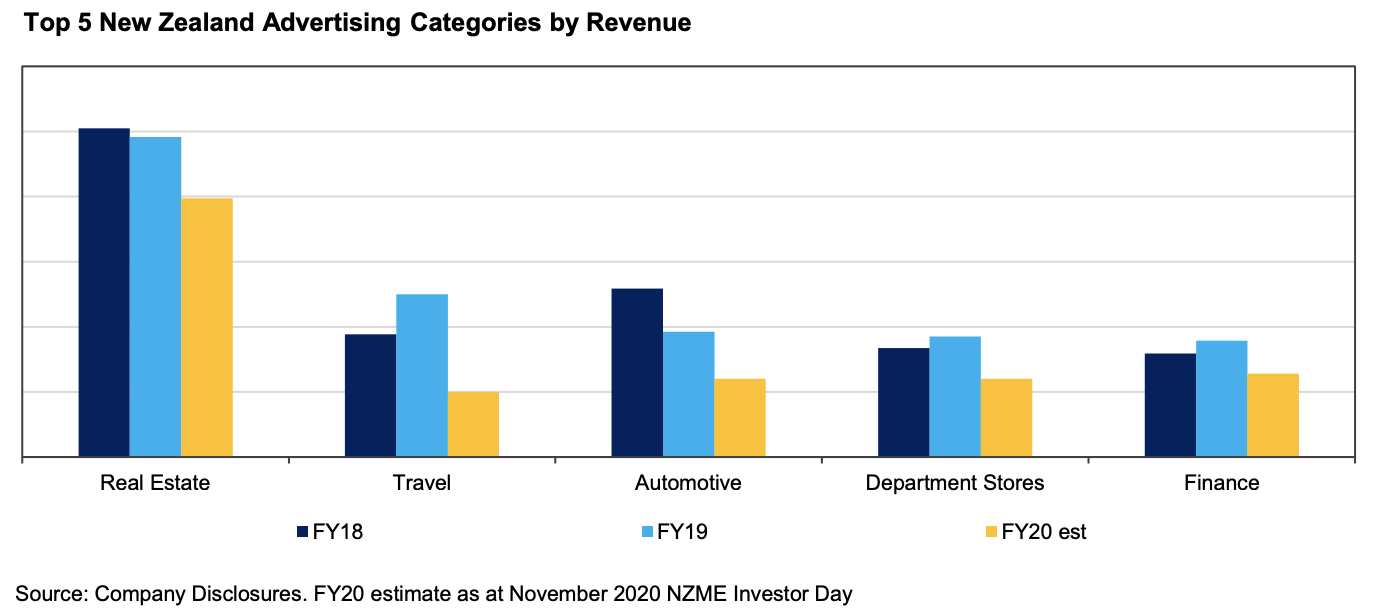
Secondly, NZME used the COVID-19 period to make NZ$20m of permanent cost reductions, which is material in
the context of 2021 EBITDA of NZ$49m. Importantly, a permanently reduced cost base leads to greater leverage
to a recovery in the major New Zealand advertising markets and future digital growth. Management reaffirmed at
NZME’s November 2021 Investor Day that they are targeting a meaningful uplift in EBITDA margins in the coming
years.
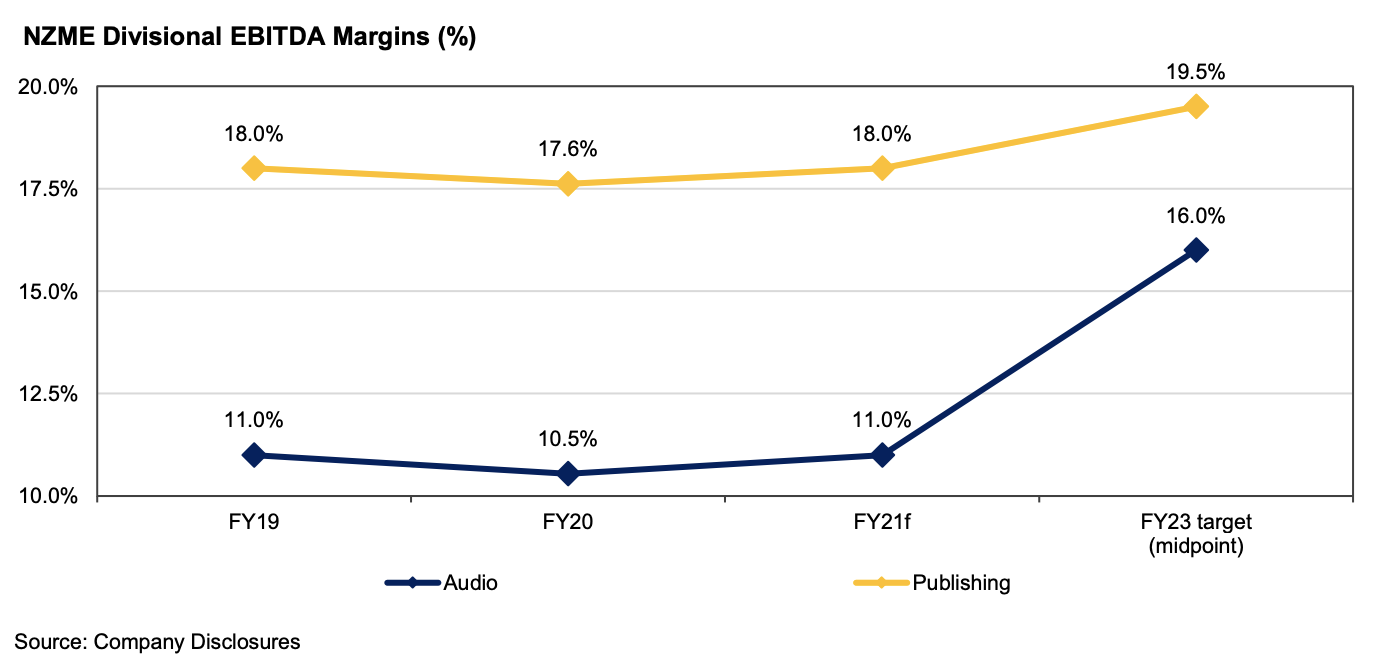
Finally, NZME has used COVID-19 as an opportunity to fortify its balance sheet. To achieve this goal, NZME has aggressively cut costs, sold its non-core daily deals business GrabOne and temporarily suspended dividend payments.
The result has been a move from net debt of almost NZ$100m (1.8x net debt / EBITDA) to a current net cash position. This has put NZME in the position to restart dividend payments and launch an up to NZ$30m onmarket share buy-back, representing approximately 12% of NZME’s current market capitalisation.
Based on
NZME’s target leverage range of 0.5 – 1.0x historical EBTIDA and FY21 EBITDA guidance of NZ$49m, NZME has
scope to almost double the size of this buyback in the future.
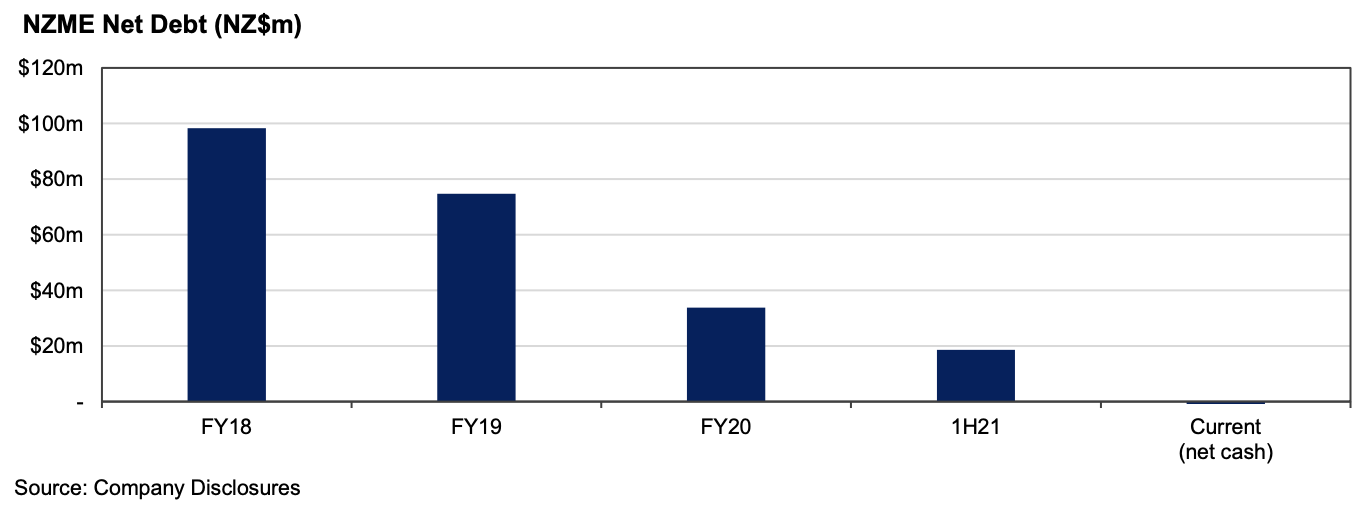
Digital classifieds
We consider one of the most exciting aspects of NZME to be the trajectory of its online property classifieds business OneRoof, launched in 2018. Leveraging a traditional media presence to launch leading digital businesses is a wellworn path in Australia - think REA Group, Domain Holdings and Stan. OneRoof has already become the second most popular property portal in New Zealand and reached 89% of the residential listings of market leader, TradeMe, largely through promotion to The New Zealand Herald’s audience. However OneRoof is currently significantly under-monetised. The depth and yield levers are yet to be pulled. COVID-19 temporarily impacted property listings and the incredible strength of New Zealand’s property market reduced the need for agents to advertise or digitally upgrade property listings. Only 12% of OneRoof listings (30% in Auckland where The New Zealand Herald is based, 8% elsewhere) currently pay for a premium depth upgrade, well below management’s 2023 targets (50% in Auckland and 22% regional).
OneRoof has also been run at an essentially breakeven level since inception.
However, management has recently announced that it is targeting a 15-25% EBITDA margin by 2023. If OneRoof
delivers on this plan, we expect it to receive much more investor attention. Australia’s number two property portal,
Domain, currently trades at a 26x EBITDA multiple and a 9x revenue multiple. Applying these metrics to OneRoof’s
2023 targets leads to a 9 figure valuation, which is clearly material in the context of NZME’s market capitalisation.
NZME also has a nascent automotive portal called ‘Driven’, where further optionality exists.
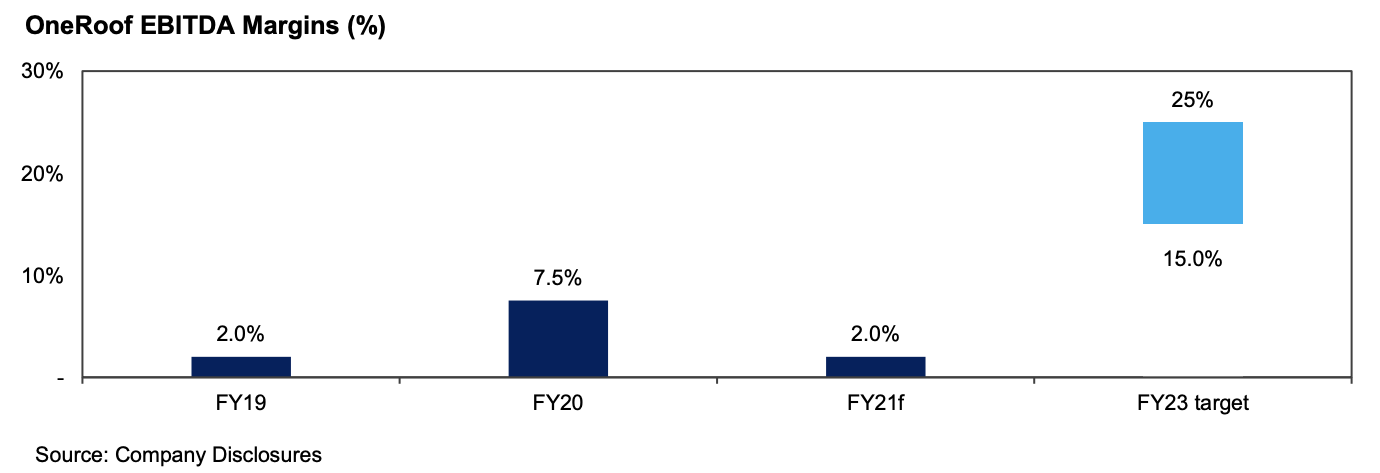
Digital platforms
In July 2019 in Australia, the ACCC released its landmark Digital Platforms Inquiry report(2). Some of the key findings were:
- Google is a critical source of traffic for news media businesses, and Facebook is a vital distribution channel for a number of media businesses;
- News content is also important for Google and Facebook: 1) Google benefits because the inclusion of news stories in search results increases the general consumer attractiveness of the search engine. 8-14% of Google searches trigger “Top Stories” results, typically being news articles; and 2) Facebook benefits as consumer engagement towards news stories leads to higher retention of consumer attention and therefore advertising revenue;
- Google and Facebook can change key algorithms with a lack of warning, implement policies and formats, and provide summary “snippets” of third-party articles – all of which can reduce the ability of publishers to fully monetise their digital content;
- The bargaining position between the digital platforms and news media businesses is imbalanced, as news platforms need the platforms more than the platforms need the media businesses;
- News media businesses risk losing a significant source of revenue if they prevent Google from providing links to their articles in search results, with Facebook also holding substantial market power; and
- A significant and adverse impact on the ability of a news media business to monetise its content or build or sustain a brand has implications for news and journalism, both of which generate important benefits for society and play a role in the healthy functioning of the democratic process.
The eventual result of these findings was the implementation of an Australian News Media Bargaining Code, the announcement of Google News Showcase including a global US$1 billion commitment towards paying publishers for journalism and deals between the digital platforms and Australian publishers. This led to the digital platforms agreeing to pay News Corporation over A$100m and Seven West Media and Nine Entertainment over A$30m per annum. Our understanding is that these payments should grow over time.
Having watched this process with interest, New Zealand media publishers have begun the process of attempting to replicate this outcome, with New Zealand regulators appearing sympathetic to the cause. The New Zealand Publishers’ Association has sought Commerce Commission approval to collectively bargain with the platforms to achieve a favourable outcome. If NZME were to achieve a similar outcome to its Australian peers on a population adjusted basis, payments could equate to an 8 figure annual sum, a material uplift to NZME’s earnings. Whilst negotiations are in their early stages, a favourable outcome could lead to an additional income stream with little associated cost, sustainably boosting profitability.
Strong cash generation
NZME is highly cash generative and has high incremental margins, a net cash balance sheet and a double digit
return on tangible assets. NZME’s accounting depreciation tends to meaningfully exceed capital expenditure,
meaning that accounting profit understates the cash generation of the business. After a lengthy period of declining
earnings, management has guided for the core NZME business to return to profit growth from CY21 onwards.
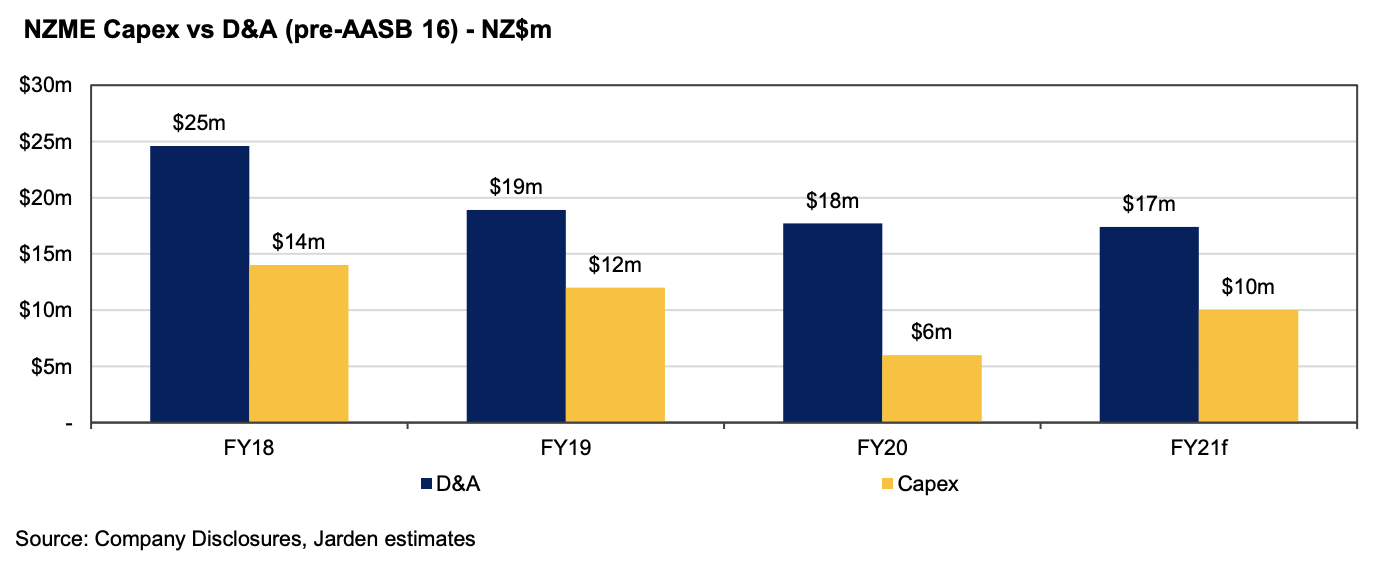
Valuation and conclusion
Since listing, NZME has been viewed as a business in structural decline. An attempted tie-up with its peer, Stuff, proved to be an expensive distraction, leverage concerns forced NZME to pause its dividend and earnings have declined. The market has responded by applying a price to earnings (P/E) multiple of less than 10 times (COVID impacted) 2021 cash net profit. However we believe that there are signs of a meaningful improvement in the outlook for the business. Demand for NZME content has continued to increase. NZME’s core business is on the pathway to becoming predominantly digital with exposure to structural and cyclical growth tailwinds. Margin expansion is within management control and the business is highly cash generative.
NZME’s balance sheet is strong, with a net
cash position and large buyback in place. In addition, management has begun to make announcements which we
think appear to signal growing confidence in NZME’s outlook, including a material buyback, the acquisition of digital
publisher BusinessDesk, proactive engagement with digital platforms and the public announcement of detailed
medium-term targets. Overall, we think a sub-10x cash P/E multiple for the core business is compelling, particularly
with New Zealand’s flagship NZX 50 Index currently trading on 33.5x P/E (3). This is before accounting for the
valuation upside if OneRoof continues to deliver on its objectives and a favourable digital platform outcome is
reached. We remain excited by the Fund’s investment in NZME.
1) 1 New Zealand Transport Agency Vehicle Register, Light Passenger Vehicle Fleet
2) You can read this here: https://www.accc.gov.au/system/files/Digital%20platforms%20inquiry%20-%20final%20report.pdf
3) S&P Dow Jones Indices, as of 31 December 2021
Never miss an update
Enjoy this wire?
Hit the 'like' button to let us know. Stay up to date with my content by hitting the 'follow' button below and you'll be notified every time I post a wire.
3 topics
1 stock mentioned

